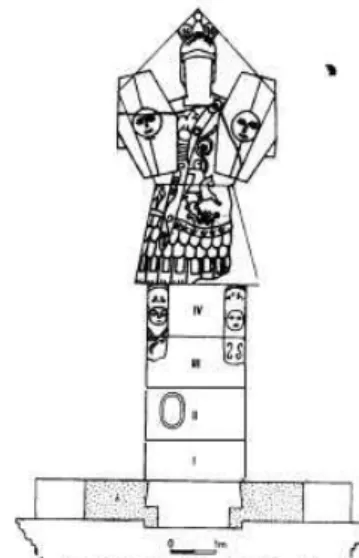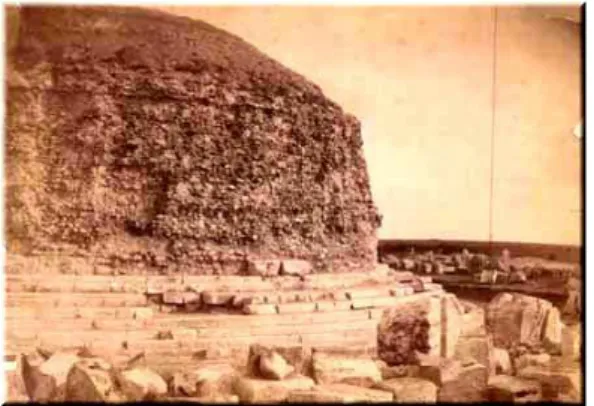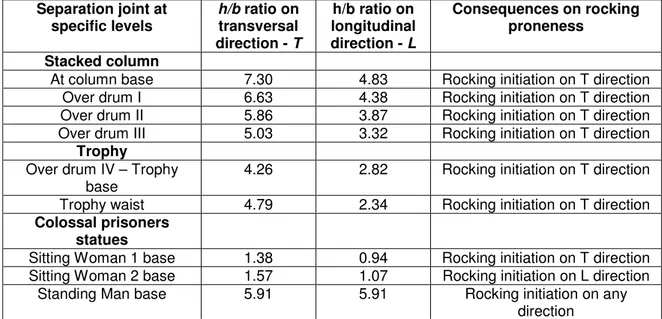CONSTRUCŢII – No. 1 / 2015 11
SEISMIC RESPONSE OF TROPAEUM TRAIANI MONUMENT,
ROMANIA, BETWEEN HISTORY AND EARTHQUAKE ENGINEERING
ASSESSMENTS
Emil-Sever GEORGESCU
Dr. Eng., National Research and Development Institute URBAN-INCERC and European Center for Buildings Rehabilitation - ECBR, Bucharest, Romania, ssever@incerc2004.ro
ABSTRACT
The paper presents the content, rationale and preliminary results of a study of the seismic response of Tropaeum Traiani monument, at Adamclisi, in Southern Dobrudja. It is a unique structure of its kind in Romania and the only Roman Empire trophy having kept the original core and a large number of stone parts. There is neither a professional assessment of the seismic source and motion size that caused the upper part overturning, nor an analysis of the monument’s dynamic response, based on the remnant pieces. The research aims at deriving the earthquake resisting capacity of specific sections based on dimensions and detailing of stone components. In order to obtain some input accelerations likely to initiate oscillation, shearing or sliding and overturning of the monument specific parts, a reverse technique is considered. The preliminary study allowed the assessment of oscillation amplification patterns at different heights, indicating the direction of collapse of upper pieces. The data are in a good correlation with some previous INCERC data about the particular directivity of some Vrancea motions in Dobrudja in 1990 and with places of stone parts unearthing. The estimation of a range of historical time for the destructive earthquake is also a goal.
Keywords: history; seismic response; Roman monument
REZUMAT
Articolul prezintă conţinutul, motivaţia şi rezultatele preliminare ale unui studiu al răspunsului seismic al Monumentului Tropaeum Traiani de la Adamclisi, din sudul Dobrogei. Este o structură unică de acest tip în România şi unicul trofeu din Imperiul Roman care a supravieţuit păstrându-se nucleul original şi un mare număr de piese de piatră. Până în prezent nu există însă nici o evaluare de specialitate a sursei seismice şi a mărimii mişcării care a produs răsturnarea părţii superioare, şi nici o analiză a răspunsului seismic al monumentului, pe baza componentelor arheologice. Cercetarea urmăreşte să determine capacitatea de rezistenţă
la cutremur a secţiunilor specifice, pe baza datelor dimensionale şi alcătuirii componentelor din piatră. Pentru a obţine date despre acceleraţia de intrare care ar fi putut iniţia oscilaţia, forfecarea sau alunecarea şi răsturnarea pieselor specifice, este avută în vedere o tehnică inversă. Studiul preliminar a permis evaluarea unor caracteristici ale amplificării oscilaţiilor la diferite înălţimi, indicând direcţia de cădere a componentelor părţii superioare. Datele sunt într-o bună corelaţie cu date anterioare ale INCERC despre directivitatea particulară a unor mişcări seismice de Vrancea în Dobrogea în 1990 şi cu locul descoperirii pieselor de piatră. Se urmăreşte şi estimarea domeniului de timp istoric pentru evenimentul care a distrus monumentul.
Cuvinte cheie: istorie; răspuns seismic; monument roman
1.INTRODUCTION
The stone structure of triumphal monument Tropaeum Traiani was completed by Romans in 109 A.D. in the North-Eastern part of Moesia Inferior, the present Southern land of Romanian Province Dobrudja, between Danube and the Black Sea. It consisted of a
E. S. Georgescu
CONSTRUCŢII – No. 1 / 2015 12
of Romans over warriors of Dacia and their allies. The diameter of the drum was some 40…43 m and the total height of monument reached some 37…40 m (Tocilescu et al, 1895) (Fig. 1).
Fig. 1. The replica of Tropaeum Traiani built in 1977 over the original core of the drum, foundation
and stepped base. Photo taken in 2014 after rehabilitation in 2012 (www.mangalianews.ro).
It is likely to have been based on a design of Apollodor of Damascus, as it was the symbolic pair of Traian’s Column in Rome, with 29.78 m height, erected in 115 AD (Fig. 2 and 3).
Fig. 2. The reconstruction of the hexagonal tower, upper part statues, a stacked column and Trophy, suggested by Furtwangler (1903).The position of
prisoner women is different in the 1977 reconstruction
Fig. 3. The reconstruction of the stacked column and Trophy suggested by Sampetru, 1984. In this version, the base piece under the first drum (noted I) is embedded in the concrete, while other authors put that piece in another position. The Trophy is
composed of two separate parts
The site included a funerary military altar for the Roman soldiers fallen in the battles and a tumulus tomb. A fortified Roman City named also Tropaeum Traiani was settled nearby. (Tocilescu et al, 1895; Florescu, F.B., 1965; Barnea et al, 1979; Sampetru, 1984)
Almost all authors agreed that the upper part of the monument could have been destroyed by an earthquake at some centuries after erection, while the sculpted metopes were dismantled, most probably by people, in a later age (Tocilescu et al, 1895; Sampetru, 1984); a hypothesis of a reconstruction in the III-rd century was suggested (Dorutiu-Boila, 1987).
In the mid-XIXth century, the partly buried core of the drum and some detached stone remnants of the Adamclisi village attracted the attention of governing Ottoman authorities of the epoch and of some travelers and historians. In 1878 Dobrudja became a province of Romania. Eventually, Romanian archaeologist Grigore Tocilescu uncovered the site in 1882 (Tocilescu et al,1895). (Fig. 4, 5).
Seismic response of Tropaeum Traiani monument
CONSTRUCŢII – No. 1 / 2015 13
and all original stone pieces are exposed in a dedicated museum.
Fig. 4. Archaeological image after unearthing of Roman concrete core and steps area, proving the
upper Trophy large stone pieces fallen in N-W (Photo: H. Jacobi, 1896. www.cimec.ro)
Fig.5. Aerial view of the original weathered core and stepped base, including the base of the hexagonal tower and remnants of perimeter blocks, in the 1960’s (Fl. B. Florescu, 1965)
2.RATIONALE FOR A STUDY OF TROPAEUM TRAIANI MONUMENT SEISMIC SETTING AND RESPONSE
The seismic response of Tropaeum Traiani monument is worth of study because of several reasons:
− the monument was unique and very
important in European and Worldwide history and history of art; its structure is the only of its kind in Romanian territory, and the only Roman trophy to survive to such extent, having kept the original core and a large number of stone parts, in a rather good state;
− although the literature about the historical
and art significance of the trophy and depicted scenes is very rich, to date there is
neither a professional assessment of the seismic source and motion size, nor an engineering assessment of dynamic response, based on the damage pattern of this monument;
− the past archaeological studies recovered
most parts of the upper section and data on the possible detailing of structure, there are some data about the places of unearthing, to be studied in correlation with seismic response and overturning;
− some records of recent Vrancea motions
were obtained by INCERC Strong Motion Network, hazard analysis are published (Sandi and Borcia, 2011), while some methods of modeling and assessment of rigid bodies motion under earthquake input evolved since 1980’s and are available. 3.PRELIMINARY RESULTS OF THE
STUDY
For Tropaeum Traiani site, the overall study of seismic setting is proving that the area is at some 150… 200 km of Vrancea seismogenic intermediate source and at some 50…100 km of local shallow / crustal sources of Black Sea Coast and Northern Bulgaria (Fig. 6).
Fig.6.SSiitteeooff Tropaeum Traiani - Adamclisi (noted TT on map) and the seismic setting of Romania..
The Vrancea and South Dobrudja sources are oposite, but quite on the same direction. (Source: Seismicity of Romania 984 ad…2013. Catalog ROMPLUS, INFP-NIEP. Black dots are Vrancea intermediate earthquakes epicenters. Red
E. S. Georgescu
CONSTRUCŢII – No. 1 / 2015 14
South-Dobrudja faults caused large earthquakes with damage and tsunami in ancient times (M 7.5 in 545? 543? A.D. at Dionissopoli, near Shabla-Kaliakra fault) (Guidoboni, 1989; Ranguelov et al, 2008).
Some archaeological data are taken as a proof that the Roman Fortress Capidava, built also by Traian on the Danube at some 50 km North of Tropaeum Traiani, was destroyed by a great earthquake or/and an invasion at the end of VI-th or beginning of VII-th century AD. (Florescu, R., 1965 and 2000-2001; Covacef, 1988-1989; www.cimec.ro).
The Vrancea earthquake of 1802 (Mw = 7.9) caused intensity of 8 MSK, while in 1940 (Mw = 7.7) and 1977 (Mw = 7.4) the intensity was 6 MSK in the area of study. There are several major faults crossing Dobrudja, but those of mid-part area were not active in the modern ages; in March 31, 1901, Mw = 7.2, I0 = X MSK, with I = VII-IX MSK
in Romanian Dobrudja. Other local faults exist in the area of study.
Using some data arising from NPP Cernavoda safety reassessment of magnitude threshold for Vrancea source (Cernavoda NPP Units 1 & 2), a maximum observed magnitude is Mw =7.7 and maximum possible magnitude is Mw = 7.9 is accepted. For Shabla Cape, the maximum observed magnitude is Mw = 7.1 and maximum possible magnitude şi Mw = 7.2. Magnitudes for Dulovo Source, Intramoesic Fault and local earthquakes are lower. The same data source (www.cne.ro) indicated in 2007 the acceleration level as a = 0.2 g for I = VIII MSK (DBE) and a = 0.1 g for I = VII MSK (SDE).
The code P100-1/2006 gives a design acceleration PGA of 0.16 g for 100 years recurrence interval, while the new zoning map of code P100-1/2013 gives a design acceleration of 0.20 g for 225 years recurrence interval (codes P100-1/2006 and P100-1/2013).
Thus, in the engineering seismology part, the study checked how and if the Vrancea or Dobrudja sources would have been affecting the monument; enabling a comparison between seismic sources. On the other hand, checking the hypothesis and consequences of a
motion with similarities of one of the May 30, 1990 Vrancea earthquakes recorded by INCERC in Cernavoda, having some effects just in Adamclisi Museum, proved a directivity that was different of Vrancea usual motions (Sandi and Borcia, 2011) (Fig, 7).
Fig.7.SSpecific graphs for INCERC records of May 31,1990 at Cernavoda. Radiation for event 1990.05.31. Maximum direction is towards SE at
142.5 degrees. Directions towards Cernavoda or Adamclisi are strongly to SE (Borcia, 2008)
In the engineering part, the study was directed towards checking data of size, arrangement and detailing and suggesting alternative hypotheses for a structural – dynamic model of base construction and of upper stack of statues and trophy, which may differ of the reconstruction of 1977, based on existing parts and engineering assessment. In order to derive on this background the earthquake resisting capacity of specific sections, a reverse technique is intended to obtain some input accelerations likely to have been able to initiate shearing, oscillation and overturning of specific parts of the monument, and, if possible, correlations with spectral content of motion, in the next phases of research.
CONSTRUCŢII – No. 1 / 2015 15 Table 1. Height to width ratio (h/b), as form and sensibility-oscillation amplification factors to overturning, for
column, statues and Trophy at different separation joints
Separation joint at specific levels
h/b ratio on transversal direction - T
h/b ratio on longitudinal direction - L
Consequences on rocking proneness
Stacked column
At column base 7.30 4.83 Rocking initiation on T direction Over drum I 6.63 4.38 Rocking initiation on T direction Over drum II 5.86 3.87 Rocking initiation on T direction Over drum III 5.03 3.32 Rocking initiation on T direction
Trophy
Over drum IV – Trophy base
4.26 2.82 Rocking initiation on T direction
Trophy waist 4.79 2.34 Rocking initiation on T direction
Colossal prisoners statues
Sitting Woman 1 base 1.38 0.94 Rocking initiation on T direction Sitting Woman 2 base 1.57 1.07 Rocking initiation on L direction
Standing Man base 5.91 5.91 Rocking initiation on any direction
Note: For each section, the rocking can start on the direction corresponding to the greater ratio value. It was presumed that all pieces remain assembled up to the respective joint, and height is for all pieces above. The order and dimensions of drums are as in Sampetru, 1984, see Fig. 3
Fig.8. Approximate place of unearthing of stone pieces near the Monument’s core, as described by
Tocilescu, seem to be strongly correlated with the direction of motions sources, as well as with the
proneness of rocking given by their geometry. The Trophy was found in N-W, the column drums
in S…S-W, one woman and the prisoner were in E-N-E, while the second woman was in W-S-W (Georgescu, 2014, considering data of Tocilescu et
al, 1895, correlated with F. Bobu Florescu, 1965)
Some hypotheses on patterns and mechanisms of upper parts collapse, including the possibility and extent of collision between falling and base parts during collapse, were tested (Fig. 9).
Fig.9. A visual modeling of possible collapse pattern for stacked upper column and Trophy stone
pieces. The damage pattern of prisoners statues, hexagonal tower, merlons, parapets and metopes
is not depicted (Georgescu, 2014)
4.ABOUT THE HISTORICAL TIME OF DAMAGING EARTHQUAKE
CONSTRUCŢII – No. 2 / 2015 16
century (Enescu et al, 1974). Since the data in the first thousand of years AD are scarce, and a backward assessment of how would have struck Vrancea during the first millennium is not yet available, the study will include an attempt to estimate a range of historical span of time for the event that destroyed the monument. It would be of interest to evaluate whether the physics of the Vrancea source may allow quasicycles or supercycles (as in Purcaru, 1974) but without large events inside a century, while greater events occurred at 100…300 years interval, proving thus a considerable time-gap. Reversely, if the intra-century earthquakes and said cycles existed, as in the last thousand of years, their traces in the life disturbances of ancient civilizations must be investigated.
5.CONCLUSIONS
The study of the seismic response of Tropaeum Traiani monument is bridging the gaps between history, archaeology, seismology, architecture and earthquake engineering, while reinterpreting data gathered separately by each discipline across of over 120 years. Starting from forensic engineering studies, a new insight is possible, with results useful for earthquake design of important facilities in the area. In this respect, there is a need of traces and historical data recovery and interpretation. (Georgescu, 2004; 2014).
Some preliminary results allowed the assessment of oscillation amplification patterns at different heights, indicating the direction of collapse of upper pieces. The data are in a good correlation with some previous INCERC data about the particular directivity of some Vrancea motions in Dobrudja in 1990 and with places of stone parts unearthing. ACKNOWLEDGEMENTS
The author gratefully acknowledges that an extended abstract of this paper was accepted to the Second European Conference on Earthquake Engineering and Seismology, 2ECEES, August 24-29, 2014, Istanbul, Turkey and an oral version was presented.
REFERENCES
1. Barbu, V., Schuster, C., Grigore G. Tocilescu şi “Cestiunea Adamclisi”. Pagini din istoria arheologiei româneşti) (in Romanian)/Grigore G. Tocilescu and the „Adamclisi issue”. Pages of Romanian archaeology history, Cetatea de Scaun Publishing House, Târgovişte, Romania (2006).
2. Barnea, A., Bogdan Cătăniciu, B.I., Barnea, I. (Coordinator), Tropaeum Traiani I - Cetatea (in Romanian)/Tropaeum Traiani. I. The Fortress, Editura Academiei Republicii Socialiste Romania, 257 pp., 1979.
3. Borcia, I.S., Procesarea înregistrărilor mişcărilor seismice vrâncene puternice (in Romanian)/ Processing of Vrancea strong motions records, Editura Societăţii Academice „Matei-Teiu Botez”, Iaşi, 2008.
4. Covacef, Z., Capidava in the VI-th Century AD. Some remarks based on research in sector V-th of the fortress (in Romanian), Pontica, 21-22, p. 187-196, 1988-1989.
5. Dorutiu-Boila, E., Inscripţia votivă a monumentului triumfal Adamclisi (in Romanian)/The votive inscription of Adamclisi triumphal monument– Studii Clasice XXV, Ed. Academiei Republicii Socialiste Romania, pp. 45-46, 1987.
6. Enescu, D., Marza, V., Zamarca, I., Contributions to the statistical prediction of Vrancea earthquakes, Rev. Roum. Geophys., 18, 67, 1974.
7. Florescu, F.B., Das Siegesdenkmal von Adamklissi, Tropaeum Traiani, Verlag Der Akademie Der Rumanischen Volksrepublik, Bukarest, Rudolf Habelt Verlag, Bonn, 1965.
8. Florescu, R., Capidava, Meridiane Publishing House, Bucharest, Romania (in Romanian), 1965.
9. Florescu, R., Des tremblements de terre et des invasions en Scythie Mineure pendant l'Antiquité tardive, Pontica, 33-34, p. 451-457, 2000-2001. 10. Furtwängler, A., Das Tropaion von Adamklissi und
provinzialrömische Kunst. München, Verlag der K.
Akademie. 1903.
https://ia902205.us.archive.org/19/items/dastropaio nvonad00furtuoft/Dastropaionvonad00furtuoft_bw. pdf.
11. Georgescu, E.S., Forensic engineering studies on historical earthquakes in Romania, Proc. 13-th World Conference on Earthquake Engineering Vancouver, B.C., Canada, August 1-6, Paper No. 2444, 2004.
12. Georgescu, E.S., Monumentul Tropaeum Traiani
Seismic response of Tropaeum Traiani monument
CONSTRUCŢII – No. 1 / 2015 17
de Arheologie „Vasile Pârvan” al Academiei Române, 24 - 26 aprilie 2014, Bucureşti, 2014.
13. Guidoboni, E. (Editor), I Terremoti prima del Mille in Italia e nell'area mediterranea, ING Roma-SGA Bologna, Storia - Geofísica - Ambiente, Italia, 1989.
14. Purcaru, G., Quasi-and supercyclicity of earthquakes and time-magnitude gaps in earthquake prediction, Tech. Rep. NORSAR Sci. Rep., No. 6-73/74, 53–55, 1974.
15. Ranguelov B., Mircheva, E., Lazarenko, I., Encheva, R., The archaeological site – possible evidence about multihazard ancient events, Proc. Conf. Geoarchaeology and Archaelomineralogy, 347-352 pp., 2008.
16. Sampetru, M., Tropaeum Traiani II Monumentele romane (in Romanian)/Tropaeum Traiani II. Roman monuments, Editura Academiei Republicii Socialiste Romania, Bucuresti, 1984.
17. Sandi, H., Borcia, I.S., A summary of instrumental data on the recent strong Vrancea earthquakes, and implications for seismic hazard, in Pure and Applied Geophysics, 2011, Volume 168, Numbers 3-4, Pages 659-694, ISSN 0033-4553, 2011.
18. Seismic Design Code P100 Part 1 - P100-1/2006, Design Provisions for Buildings (in Romanian), Published in: Monitorul Oficial Partea I, No. 803 bis / 25.09.2006 and Seismic Design Code P100 Part 1 - P100-1/2013 in: Monitorul Oficial Partea I, No. 558 bis / 3.09.2013, Bucharest, Romania.
19. Tocilescu, G., Benndorf, O., Niemann, G., Monumentul de la Adamklissi, Tropaeum Traiani, Viena (in Romanian)/The Monument of Adamklissi, Tropaeum Traiani/ In German - Das Monument von Adamklissi, Wien, 1895.
20. http://www.cne.ro/... Cernavoda NPP Units 1 & 2, Romania safety features of CANDU 6 design and stress test Summary Report, (in Romanian), 93 pp. Accessed 2012 .
21. http://www.cimec.ro/Arheologie/Capidava/realizat. htm
22. http://www.infp.ro/catalog-seismic


